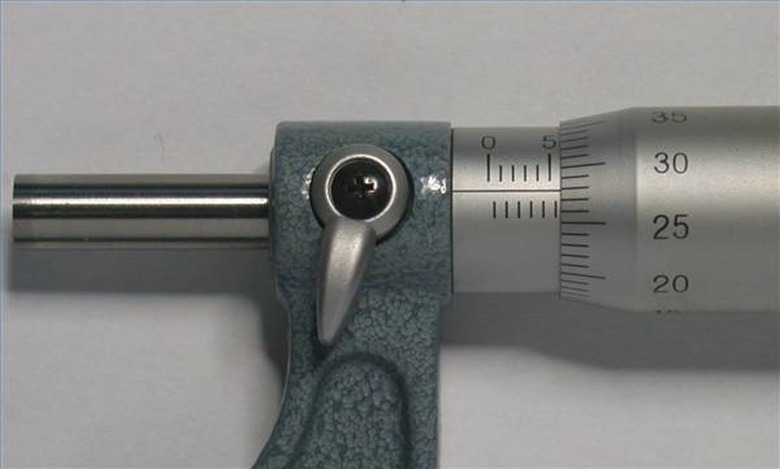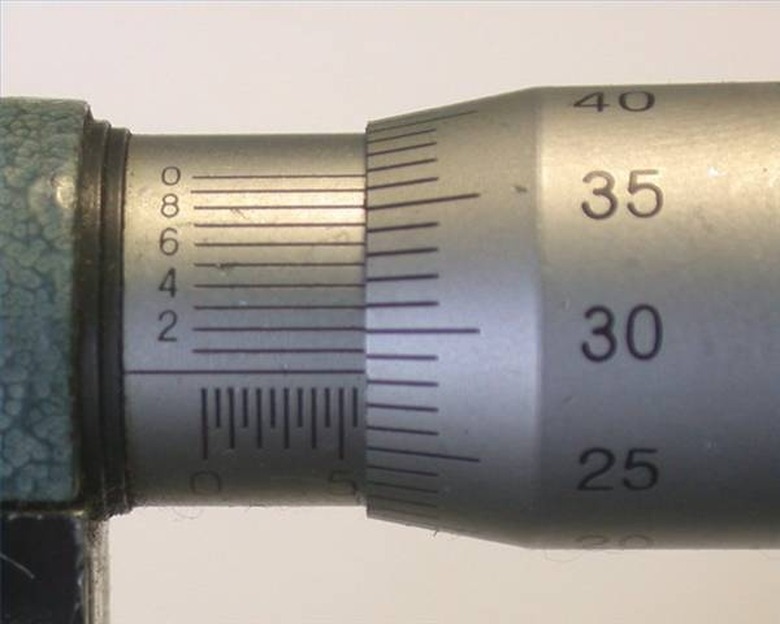How To Read A Metric Micrometer
When measuring things like the inside radius of a tube or the diameter of a sphere, a micrometer will give you a very accurate result. The most common type of micrometer, the screw gauge, has precisely machined threads in the handle that are used to advance and retract a shaft, or spindle. When the spindle is advanced, the number of turns or partial turns on the threads is measured using a gauge stamped into the handle. This gauge can be in either English or metric units.
Step 1
Set the micrometer on the object to be measured. For inside micrometers, this means it is stretched across the inner diameter of the tube or pipe, and for a depth micrometer, it means it is resting on the rim of the bowl or channel and the spindle is resting on the bottom. For an outside micrometer, the object being measured should be lightly held between the spindle and the anvil.
Step 2
Use the micrometer's locking mechanism to hold the shaft in place. This will most likely be a thumb lever or thumb wheel located near the spindle.
Step 3
Read the linear gauge, which is in millimeters, and then read the barrel gauge. The barrel gauge will be divided into increments depending on the step size of the linear gauge. For metric micrometers that use millimeters in half-step increments, the barrel gauge will have 50 increments. The barrel gauge is abbreviates so that "28" equals 0.28 mm.
Step 4
Combine the two readings. A reading of "5.5" on the linear gauge and "28" on the barrel gauge equals a total of 5.78 mm.
Step 5
Use a vernier scale. The scale goes from 0 to 10. The increments are spaced so that only one increment will perfectly align with the barrel gauge at a time. Whichever line aligns with the barrel gauge, regardless of which number it aligns with, is the next digit in the measurement. A reading of 5.78, with a vernier reading of "3" equals 5.783 mm.
TL;DR (Too Long; Didn't Read)
Sliding caliper micrometers also use a vernier scale and are read in the same way.
Warning
Micrometers are very precise and very sensitive to heat, cold and impact. Treat your micrometer with care.
Cite This Article
MLA
McKenzie, Grant D.. "How To Read A Metric Micrometer" sciencing.com, https://www.sciencing.com/read-metric-micrometer-4841843/. 24 April 2017.
APA
McKenzie, Grant D.. (2017, April 24). How To Read A Metric Micrometer. sciencing.com. Retrieved from https://www.sciencing.com/read-metric-micrometer-4841843/
Chicago
McKenzie, Grant D.. How To Read A Metric Micrometer last modified March 24, 2022. https://www.sciencing.com/read-metric-micrometer-4841843/

